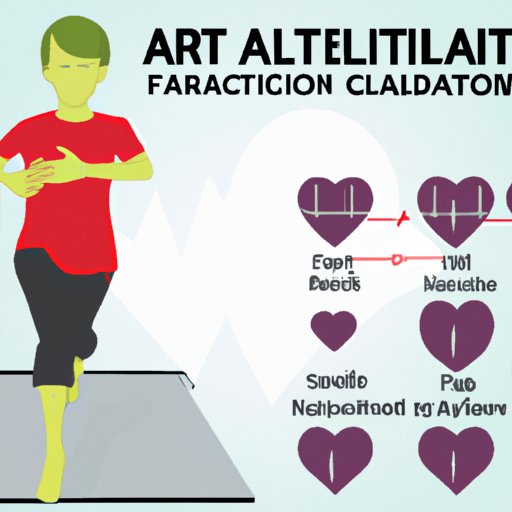Introduction
Atrial fibrillation (AFib) is an irregular heartbeat caused by electrical signals in the heart that are out of sync with each other. It is one of the most common heart rhythm disorders, affecting approximately 2.7 million Americans and 33.5 million people worldwide. While there is no cure for AFib, research has shown that regular exercise can help reduce symptoms and improve quality of life.
Examining the Types of Exercise Best Suited for Atrial Fibrillation Sufferers
When it comes to exercise, there are several types that may be beneficial for AFib patients. These include cardiovascular exercises, strength training, and yoga. Let’s take a closer look at each one.
Cardiovascular Exercises
Cardiovascular exercises, such as running, jogging, cycling, and swimming, are excellent for improving heart health and reducing stress levels. According to a study published in the journal Circulation, aerobic exercise can reduce the frequency of AFib episodes and reduce the risk of stroke in AFib patients. Additionally, regular aerobic exercise can help lower blood pressure and cholesterol levels, both of which are important for maintaining good heart health.
Strength Training
Strength training is another type of exercise that can be beneficial for AFib patients. According to a study published in the journal Circulation: Cardiovascular Quality and Outcomes, strength training can reduce AFib symptoms and improve overall quality of life. Additionally, strength training can help reduce body fat, increase muscle mass, and improve bone density, all of which can contribute to better health.
Yoga
Yoga is another form of exercise that can be beneficial for AFib patients. A review published in the journal Complementary Therapies in Medicine found that yoga can help reduce stress and anxiety, improve sleep quality, and lower heart rate and blood pressure. Additionally, yoga can help improve balance, flexibility, and posture, all of which can help reduce the risk of falls in AFib patients.

A Look at How to Design a Safe and Effective Exercise Program for Atrial Fibrillation
Before beginning any exercise program, it is important to consult with your doctor. Your doctor can provide advice on the types of exercise that are best suited to your individual needs and help ensure that you are exercising safely. Additionally, it is important to understand your limitations and set realistic goals. For example, if you have not been exercising regularly, it may be best to start slowly and gradually build up your activity level.
It is also important to incorporate variety into your workout. This means doing different types of exercise on different days. For example, you could do cardiovascular exercises one day and strength training the next. This will help keep your workouts interesting and prevent boredom.

Comparing Cardio Exercises for Atrial Fibrillation Patients
When it comes to cardiovascular exercises, there are several types that may be beneficial for AFib patients. These include low impact aerobics, swimming, and walking. Let’s take a closer look at each one.
Low Impact Aerobics
Low impact aerobics are an excellent choice for AFib patients. This type of exercise is gentle on the joints and can help improve cardiovascular fitness without putting too much strain on the body. Examples of low impact aerobics include water aerobics, tai chi, and dance classes.
Swimming
Swimming is another great option for AFib patients. Swimming is low impact and can help improve cardiovascular fitness, muscle strength, and endurance. Additionally, the buoyancy of the water can help reduce the stress on the joints.
Walking
Walking is a great way to get exercise for AFib patients. Walking can help improve cardiovascular fitness, muscle strength, and balance. Additionally, walking is low impact and easy to do. It can also be done almost anywhere, making it an ideal exercise for AFib patients.
Understanding the Risks and Benefits of Strength Training for Atrial Fibrillation Patients
Strength training can be beneficial for AFib patients, but it is important to understand the risks associated with this type of exercise. Strength training can put a lot of strain on the body and should be done with caution. It is important to use proper form and technique when lifting weights and to avoid overtraining. Additionally, it is important to listen to your body and stop when you feel pain or fatigue.
Benefits of strength training include improved muscle strength and endurance, increased bone density, and improved balance and posture. Additionally, strength training can help reduce body fat and improve overall health.

Investigating the Role of Yoga in the Treatment of Atrial Fibrillation
Yoga is another form of exercise that can be beneficial for AFib patients. It can help reduce stress and anxiety, improve sleep quality, and lower heart rate and blood pressure. Additionally, yoga can help improve balance, flexibility, and posture. However, it is important to note that some poses may be too strenuous for AFib patients and should be avoided.
Benefits of yoga include improved breathing and relaxation, increased concentration, and improved physical and mental wellbeing. Additionally, yoga can help reduce depression and anxiety, improve posture, and reduce stress.
Conclusion
Atrial fibrillation is a serious condition that affects millions of people worldwide. Regular exercise can help reduce symptoms and improve quality of life. The best exercises for AFib patients include low-impact cardio, strength training, and yoga. When designing an exercise program for AFib patients, it is important to consult with your doctor and understand your limitations. Additionally, it is important to set realistic goals and incorporate variety into your workout. By following these tips, you can create a safe and effective exercise program that can help reduce symptoms and improve quality of life.
(Note: Is this article not meeting your expectations? Do you have knowledge or insights to share? Unlock new opportunities and expand your reach by joining our authors team. Click Registration to join us and share your expertise with our readers.)
